
December 28, 2018
11 Must Have Web Site Features For Hawaii Business Web Sites
Secure Sockets Layer (SSL) Certificate
Terms of Use
Disclaimers
Hear from Harry A. Saunders, President of Castle & Cooke Hawaii, on his 20 years of experience working with Team Vision.
- How to Select The Best Hawaii Advertising Agency for Your Business
- How AI Will Transform Marketing
- What Is IP Targeting and How Can I Use It for My Business?
- Everything You Need to Know About Instagram’s “Hidden Likes” Test
- Hawaii Social Media Marketing Tips
- How To Succeed in Zero-Click Search SEO
- Social Media Marketing Trends
- Your Guide to Google Rich Search Features
- What to Expect After A Google Broad Core Algorithm Update
- Top 5 Facebook Story Sticker Tips
- Hawaii Search Engine Optimization – SEO Companies
- Top 10 Instagram Story Sticker Tips
- Know The Common Difference: Black Hat SEO vs. White Hat SEO
- 10 Types of Content That Will Boost Engagement
- Video Advertising is Growing – Are You Making the Shift?
- Why You Should Advertise on Facebook Messenger
- Buying Instagram Followers – Is It Worth The Money?
- Top 10 Instagram Hashtag Tips for 2019
- 2018 Social Media Trends: Were We Right On The Money?
- Dreaded Advertising Agency Requests Roundup
Call Us Today at (808) 536-0416.
Sources:
http://time.com/12933/what-you-think-you-know-about-the-web-is-wrong/
https://www.youtube.com/watch?v=OlbJKOWEPEM
https://www.godaddy.com/garage/does-your-website-really-need-terms-of-use/
https://www.nielsen.com/us/en/insights/news/2012/trust-in-advertising–paid-owned-and-earned.html
https://blog.hubspot.com/service/get-customer-reviews
https://support.google.com/webmasters/answer/80471
https://blog.hubspot.com/marketing/how-to-reduce-your-websites-page-speed
https://contentmarketinginstitute.com/wp-content/uploads/2017/09/2018-b2b-research-final.pdf
https://www.socialmediatoday.com/news/20-web-design-stats-you-need-to-know-first-infographic/524656/

November 22, 2018
Busting Social Media Myths #4
Busting Social Media Myths #4
It’s common knowledge among digital marketing agencies that Social Media Marketing is an essential marketing tool, but some businesses still believe in some misconceptions surrounding it. Believing in these myths can affect the quality and growth of your brand’s social media presence. Team Vision Marketing’s team feels obligated to bust some of these common myths and help guide your business in the right direction. In this edition of Busting Social Media Marketing Myths, our team will weigh in on which online advertising networks are most popular, audience targeting, and sustainable methods for growing your social media follower counts.
Make sure to read Busting Social Media Marketing Myths #1, Busting Social Media Marketing Myths #2, and Busting Social Media Marketing Myths #3 for more busts on social media marketing myths.
MYTH 1: Facebook And Instagram Are The Only Effective Social Media Platforms To Advertise On.
Although Facebook Ads, which distributes social media ads on both Facebook and Instagram, is the dominant social media advertising network, agencies and brands shouldn’t disregard advertising on other social media platforms, such as YouTube and SnapChat. In fact, these other social media advertising networks have been improving their operating systems to increase advertising effectiveness and ROI. Digital agencies recognize the potential and value of these smaller social media advertising networks, as seen in the graphic below by Clutch.
Team Vision Marketing recommends that brands be open-minded and research how you can potentially utilize these smaller social media advertising networks in your digital marketing plans. Here are some pros and cons of each.
YouTube:
Pros
-
-
YouTube is used by a wide range of age groups.
-
- It’s a creative platform with six different ad formats. Skippable video ads (a.k.a. TrueView ads), Non-skippable video ads, 6-second Bumper ads, Overlay ads, Display ads, and Sponsored cards.
- There are 1.5 billion monthly users that watch one billion hours of YouTube videos daily. YouTube mobile video consumptions are increasing by 100% every year, according to HubSpot.
- Video ads are an effective form of digital marketing/advertising. A 2016 study by Google and comScore found that 48% of online video viewers prefer YouTube as their top video site. Videos provide agencies and brands the opportunity to tell their story and educate their target audiences with their products or services in a creative way. With video ads, advertising can be engaging, compelling, and entertaining.
- Keyword targeting on YouTube can be less expensive than keyword targeting on Google with views costing an average of $0.06 per click on YouTube (HubSpot).
- YouTube Ads and videos can improve your SEO ranking.
- There are new audience targeting developments. In addition to the YouTube behavioral video viewing algorithm, YouTube advertisers will be able to target viewers based on their past Google search history of products or services in the near future (HubSpot).
- Another form of YouTube Advertising can take form as a collaboration with YouTube influencers. Influencer marketing can be effective because some consumers like to watch testimonials, reviews, or product demo videos before buying a product or service (Forbes). In fact, more than 80% of people trust online reviews as much as personal recommendations, like unboxing videos (Forbes). 90% of YouTube users say that product videos are helpful in the decision process and after watching a video, 64% of users are more likely to buy a product online (HubSpot).
Cons
- It can cost a company a lot of time and money to produce high-quality video ads. There are numerous case studies that show that YouTube ads successfully increased brand awareness, conversions, and web site traffic. However, a successful YouTube ad depends on the quality of the video or if the YouTube influencer has a positive review of your products or service. Now that YouTube’s Director On-Site program has been terminated, small businesses will have to rely on in-house resources, an advertising agency, or YouTube recommended third-party video creating platforms to make video ads. For businesses that want to self-produce their YouTube ads, understand that it takes time to conceptualize the storyboard, write dialogue or copy for the ad, and block out shooting days. Then, it might be expensive to hire the right people to shoot, produce, and edit the video. In addition, your team might have to hire talent, rent a space to film at, and so on. Hiring or using one of the YouTube recommended third-party video creators might be a more affordable option. But the process will still require a lot of time and coordination between you and the third party video creator to create the ad.
- Influencer marketing could be costly and might not produce the results you are looking for.
- YouTube ads can be annoying. YouTube ads that play before or in the middle of a YouTube video can be seen as annoying by some. It’s easy for your audience to skip right past your ad and not pay attention to the message at all. Even so, these ads can be used effectively to create brand awareness, even with minimal viewing times.
SnapChat:
Pros:
- Agencies and brands can reach millennials and Gen Z audiences.4 million 12- to 17-year-olds will use Snapchat. Emarketer.com estimates that Snapchat will add 1.2 million new users in that age group by 2022, while Facebook will lose 2.2 million.
- About 187 million people use SnapChat 25 times per day.
- SnapChat has high engagements. SnapChat says that for every 1,000 followers a profile has, 900 of them will watch their story (Hootsuite.com). Taco Bell reports that 80% of their approximate 200,000 SnapChat friends saw their stories (Hootsuite.com). Not to mention that it’s one of the best platforms for User-Generated content.
- SnapChat has cool, interactive digital ad formats. SnapChat has three interactive ad formats: Snap Ads, Sponsored Geo-Filters, and Sponsored Lenses. When SnapChat users touch a Snap Ad, the ad can expand to a full screen video with audio, link to the brand’s web site, install an app, lead you to a long form video, or download an exclusive lens for the user to interact with. Sponsored Geo-Filters are great for increasing brand awareness and expressing the brand’s creativity. Sponsored lenses are interactive face filter animations that are really great for brand awareness and collecting user-generated content.
- SnapChat made some cool marketing upgrades. SnapChat has updated its insight features to track more valuable analytics data and improved their targeting features. According to AdWeek.com, SnapChat now offers pixels that can track web traffic, conversions, and create retargeting and lookalike audiences lists. AdWeek.com also reported that SnapChat advertisers can now upload customer email lists to match their SnapChat ads to the users.
- Ads are seen as less disruptive. Unlike Facebook, Twitter, and Instagram, ads don’t pop up on SnapChat’s feed or interrupt the user’s content. Instead, ads run in the Discover tab on the SnapChat app. Also, sponsored Geo-filters, like the ones we designed for Honua Kai Resort & Spa and Dole Plantation, and Sponsored Lenses only show up if the SnapChat user is within a brand’s geo-fence.
- Advertising costs for Sponsored Geo-Filters went down. SnapChat dropped their expensive advertising daily fees and opted to start using auction bids, like Facebook Ads and Google Ads (AdAge.com). However, according to Hootsuite, Geo-Filters can be as low as $5 to reach within the immediate location or $45 for 2 days to reach people in a city. According to AdAge.com, SnapChat is also developing a “Reach and Frequency” option for guaranteed prices according to approximate audience sizes.
- There’s less competition on SnapChat than Facebook and Instagram. This means that, potentially, the keyword targeting bids are cheaper on SnapChat Ads than for Facebook Ads. It could also mean that there is less noise for the SnapChat audience, so viewers may be more willing to watch your brand’s ads.
Cons:
- This digital advertising network is still new, and the audience is smaller than Facebook and Instagram’s advertising audience.
- Audience exposure to SnapChat ads is limited to the users that browse through the app’s Discovery tab.
- This digital advertising network is best for reaching younger people. If the target audience is older than teens and younger millennials, then it will be more effective to advertise on a different platform, like Facebook and Instagram ads.
- Sponsored Lenses can be very expensive. This ad format is not suitable for smaller businesses due to the costs required to create and code lenses, and the ad space. This is why mainly big-name brands, like Urban Decay or Pepsi, uses Sponsored Lenses.
- Designing custom Geo-Filters can be, potentially, expensive.
- SnapChat Geo-Filters are best for brand awareness. These ads can be less effective for generating increases in conversions.
MYTH 2: Targeting A Broader Audience With My Social Media Ads Will Give Me The Best Results
Yes, targeting a broader audience can generate more impressions, a greater reach, and increased clicks for your brand’s digital marketing ads, which is why this targeting strategy is ideal for increasing brand awareness, lead generation, and collecting customer data. For example, using a broad audience targeting strategy, a boutique hotel on Maui might target West Coast USA markets and bid on more vague search phrases, like “Hawaii Hotels”, instead of a more targeted phrase like “West Maui boutique hotels”. However, using less targeted filters for your brand’s digital marketing campaigns also means that the ads won’t attract the highest quality audience. You’ll wind up paying more (because you’re reaching a much larger audience), but since your audience targeting is less specific to your brand, you won’t necessarily see a proportionate increase in conversions.
If your company wants to increase sales and attract a higher quality audience to your site, then consider marketing to a specific audience with targeting filters, like location, interests, income, age, groups, and likes. For a specific audience targeting to work efficiently, your brand needs to have existing customer data, a solid idea of who your customer is, or buy data from a third-party data sharing firm. For example, a local Hawaii furniture store advertising on social media will want to specifically target an audience who is at least 25 years or older and interested in home decor or home improvements. For Google Ads, this local furniture store would find that bidding on search phrases that name a specific location or product, like “Contemporary Furniture stores on Oahu” or “Where to buy couches on Oahu”, is more effective than “couches” or just “Hawaii furniture stores”. However, targeting a highly curated audience or bidding on really specific search phrases may counteract the effectiveness of the campaign by attracting too niche of an audience, or by being too expensive.
Team Vision Marketing recommends that brands first establish their marketing goals and objectives and then determine which type of targeting strategy to implement. For our clients, we normally recommend a healthy mix of broad targeting (to attract new customers) and specific targeting (to increase conversions of existing customers) as there are benefits to both strategies.
MYTH 3: The Best Way To Gain Followers Is To Follow A Lot Of People And Then Unfollow Them.
Mass social media following, and unfollowing is an unsustainable follower growth strategy and it makes your brand seem unauthentic. And, having a lot of followers doesn’t necessarily mean that your social media profile produces great content. In fact, having a large follower base, but only receiving a small number of likes per post on Instagram, will seem strange. Brands can still follow a lot of social media profiles, but the motivation behind your follows should be that the brands you follow are somehow relevant to your business, or they produce great content of interest to you and your customers. Our recommendation: don’t follow people and brands for the sole purpose of trying to get them to follow you back.
The best way to grow your social media followers is to produce quality posts and to interact in a meaningful manner with the pages you follow by liking and commenting on posts you enjoy.
Here are a few more suggested tips from Team Vision Marketing that will help you gain followers:
- Create a good social media strategy.
- Use free social media insights or social media analytics tools to determine the best times to post and what posts work for your business.
- Use hashtags and tag a location on your posts.
- Post high-quality content that brings value to your audience consistently.
- Follow relevant profiles, companies, and influencers.
- Promote your page or sponsor posts when relevant.
- Collaborate with another profile with a bigger following, or with a social media influencer.
- Incorporate promotions and/or incentives to encourage people to follow you. But remember, to keep them as followers long-term, you’ll have to consistently produce quality content.
It’s important to note that these social media marketing strategies and tactics will require a substantial investment of your time and energy on an ongoing basis. If your company doesn’t have an in-house social media management expert, it’s recommended that you hire a social media management team or a digital marketing agency to manage your social media accounts.
Does your business need assistance with managing your social media accounts? Give Team Vision Marketing a call and let us help you out. Be sure to check out some of our creative social media campaigns and promotions on our web site portfolio at www.www.teamvision.com/portfolio/#social-media.
Phone: (808) 536-0416
Email: info@www.teamvision.com
Hear from Bruce Barrett, VP of Sales & Marketing at Castle & Cooke Hawaii, on his experience working with Team Vision Marketing.
- How to Select The Best Hawaii Advertising Agency for Your Business
- How AI Will Transform Marketing
- What Is IP Targeting and How Can I Use It for My Business?
- Everything You Need to Know About Instagram’s “Hidden Likes” Test
- Hawaii Social Media Marketing Tips
- How To Succeed in Zero-Click Search SEO
- Social Media Marketing Trends
- Your Guide to Google Rich Search Features
- What to Expect After A Google Broad Core Algorithm Update
- Top 5 Facebook Story Sticker Tips
- Hawaii Search Engine Optimization – SEO Companies
- Top 10 Instagram Story Sticker Tips
- Know The Common Difference: Black Hat SEO vs. White Hat SEO
- 10 Types of Content That Will Boost Engagement
- Video Advertising is Growing – Are You Making the Shift?
- Why You Should Advertise on Facebook Messenger
- Buying Instagram Followers – Is It Worth The Money?
- Top 10 Instagram Hashtag Tips for 2019
- 2018 Social Media Trends: Were We Right On The Money?
- Dreaded Advertising Agency Requests Roundup
Call Us Today at (808) 536-0416.
Sources:
https://www.godaddy.com/garage/google-adwords-vs-facebook-ads-which-is-right-for-your-business/
https://adespresso.com/blog/facebook-ads-vs-google-adwords/
https://www.hubspot.com/marketing-statistics
https://www.facebook.com/business/help/203183363050448
https://www.pwc.com/gx/en/retail-consumer/assets/consumer-trust-global-consumer-insights-survey.pdf
https://www.cnbc.com/2018/01/04/cowen-facebook-vs-google-digital-ad-business.html
https://blog.hootsuite.com/social-media-advertising-stats/
https://www.cpcstrategy.com/blog/2017/11/facebook-broad-audience-targeting/
https://later.com/blog/get-more-instagram-followers/
https://blog.hootsuite.com/how-to-get-more-instagram-followers-the-ultimate-guide/
https://forbusiness.snapchat.com/
https://www.adweek.com/digital/snapchat-story-ads-work-heres-how-to-see-success-in-seconds/
https://neilpatel.com/blog/explore-snapchat-ads/
https://blog.hootsuite.com/snapchat-ads/
https://www.emarketer.com/content/facebook-is-tops-with-everyone-but-teens
https://blog.hubspot.com/marketing/youtube-video-advertising-guide
https://neilpatel.com/blog/how-to-use-youtube-ads-to-grow-your-business/
https://techcrunch.com/2018/03/20/get-ready-to-start-seeing-more-local-ads-on-youtube/amp/
https://blog.hubspot.com/marketing/video-marketing-statistics#sm.0000h4rgwfoa1fouwqm23llpma557
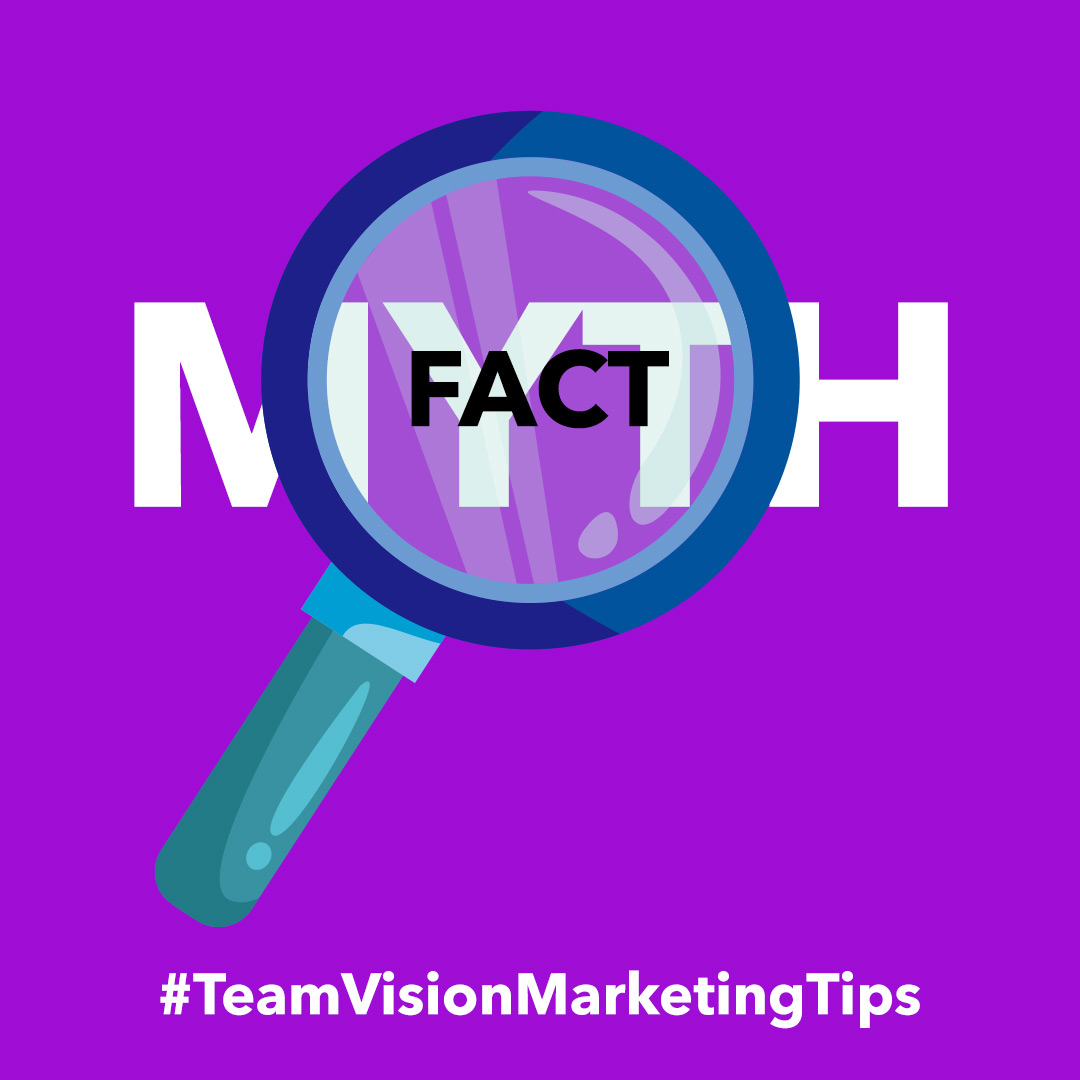
July 12, 2018
Busting Social Media Marketing Myths #3
Busting Social Media Marketing Myths #3
Welcome to part three of Busting Social Marketing Myths. Social Media Marketing has been an essential tool for digital marketing agencies for years now, but some businesses still believe in some misconceptions surrounding it. Believing in these myths can prevent you from having a good social media presence. We feel it’s our responsibility to bust some of these common myths and help steer your business in the right direction.
Make sure to read Busting Social Media Marketing Myths #1 and Busting Social Media Marketing Myths #2 for more busts on social media marketing myths.
Myth: Social Media Is Just A Sales Tool
Social media is a unique marketing channel, where brands can connect with their followers. It’s not all about making sales, it’s also about cultivating a community. If your feed is all about brand promotion and every post is always in a corporate voice, it will make the feed feel ingenuine and it might discourage the followers from wanting to engage with your posts.
To cultivate your community, we suggest that your brand do three things:
- Post a variety of content to keep your feed interesting and refreshing. To get some ideas on what types of content to post, read “Social Media – Tips”.
- Engage with your audience by replying to their comments on posts, following them, and liking and commenting on their posts.
- Spark a conversation on your feed by encouraging your followers to give their input or answer a thought-provoking question. Then, respond to their comments. Make sure to tag their handle in the reply, so they get a notification of your response.
Myth: I Must Post My Own Content ONLY
Social media was created for people to share and spread content, so your brand shouldn’t feel like it has to be the sole content creators on your social media profiles. We get it, sometimes your team doesn’t have the time or the resources to constantly develop their own engaging content. That’s why we recommend that our clients include retweeting, sharing other people’s content, or creating repost campaigns as part of their overall social media marketing plan.
Depending on what your marketing goals are, brands can use reposts and retweets/shares to gain credibility, increase engagement, build relationships with your followers, increase brand awareness, or add personality to your feed. Brands can also combine their repost campaign with their events, contests, giveaways, and so on.
To gain credibility and increase engagements, we highly recommend that companies share articles and posts from influencers or leaders in their field. Don’t be afraid to share your opinion, explain further, question, challenge, or encourage your followers to share their thoughts on the shared post or article. Spark the conversation and get those engagements!
A good way for a brand to build stronger relationships with their followers and increase their brand awareness is to create a repost campaign. This will show people that companies care about their consumers and reposting their content can be seen as a form of consumer testimony. See examples from our Dole Plantation repost campaign below.
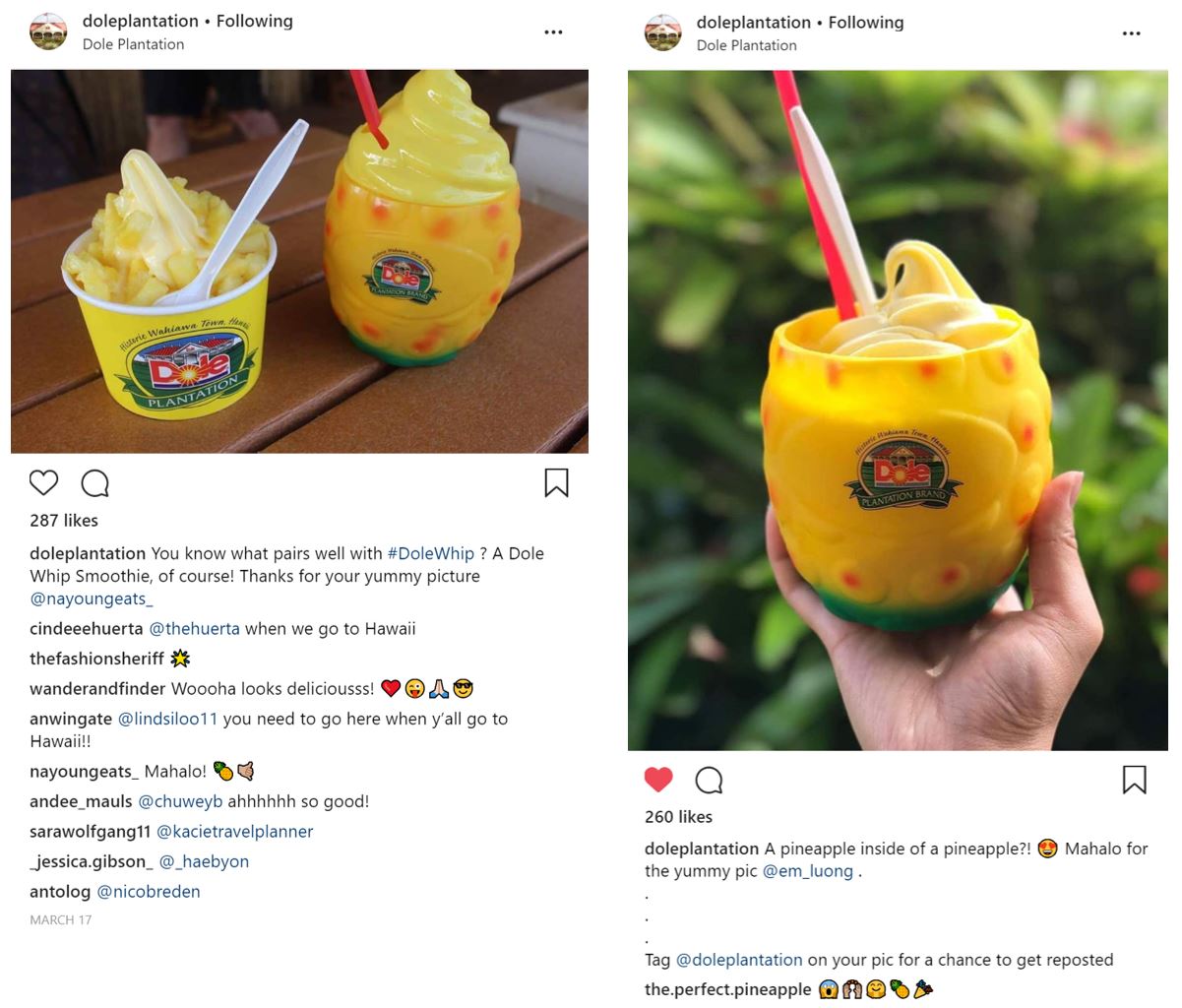
- Create a unique hashtag, preferably something that no one else is using.
- Encourage people to use it and tag your profile on their pictures.
- Then, select the best photos or posts to be shared on your feed.
Brands can also repost or retweet/share fun content that can add some personality to the feed. It can be a scenic photo of the beach, a funny GIF, a recipe, or a Buzzfeed quiz. See examples of fun shared content from Castle & Cooke Homes Hawaii’s Facebook feed below.
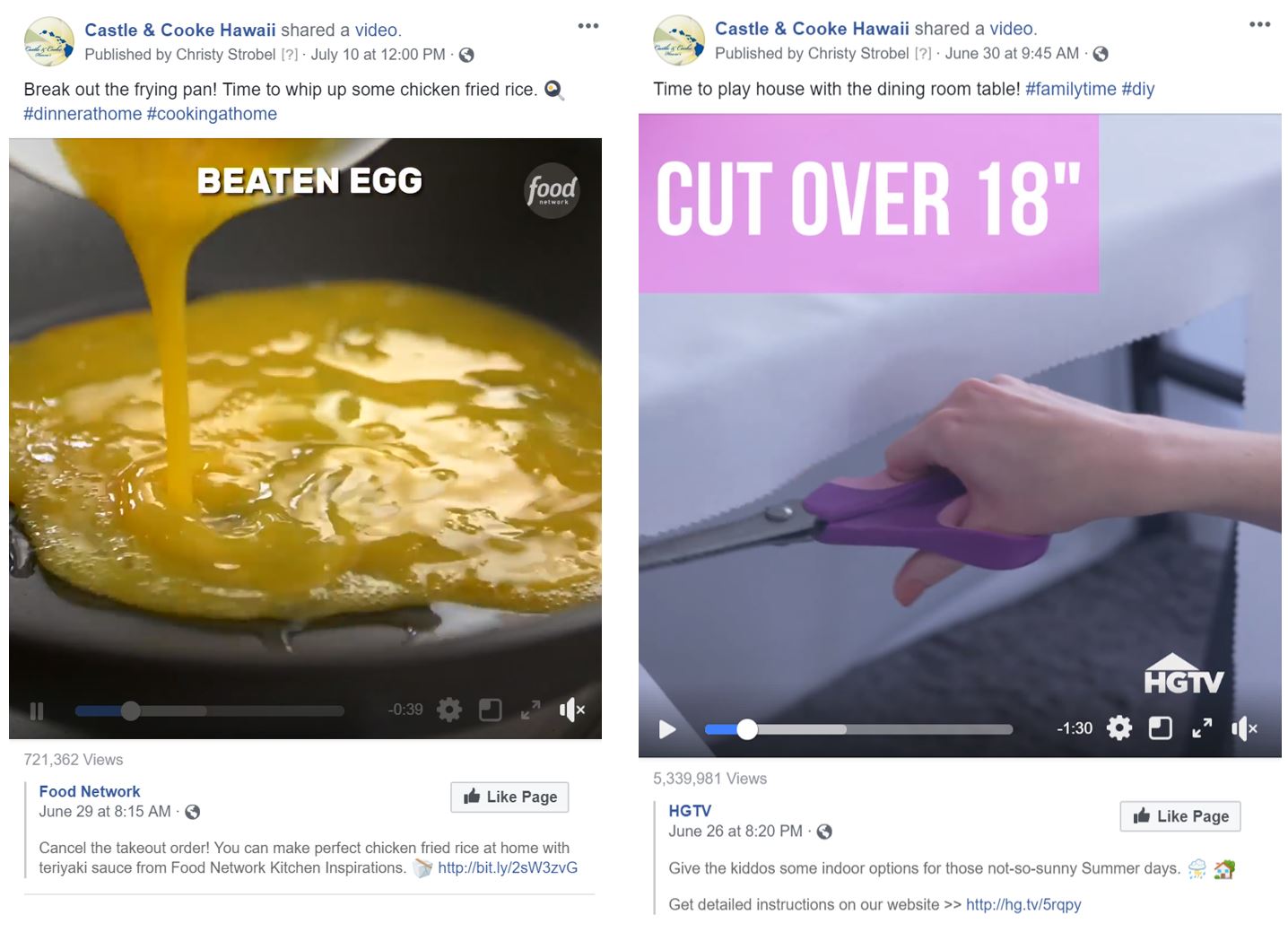
Myth: It’s OK To Just Repost/Share Images I Found
It’s vital for brands to make sure that for whatever they do on any type of media, that it’s done legally and properly. So naturally, a brand cannot just repost or retweet/share without crediting the original author or poster. “If you would normally seek out permission to use content in the offline world, you should do so when posting another’s content to social media”, says Oliver Herzfeld in “Fair Use In The Age Of Social Media“.
For reposting images, we highly suggest that brands get permission from the original poster, either in the comments section of the specific picture or by direct messaging the owner. In our experience with the repost campaigns we’re managing for our clients, their followers are more than happy to let our clients share their content, and they appreciate that we asked for their permission. Once permission is granted and documented, you should clearly state the photo credit to the original source and tag them in the repost. See the Dole Plantation reposts below as an example.

If the reposted picture is from an Influencer or photographer, you may have to pay to use their content, but this can lead to a brand partnership opportunity. If the reposted picture will be used for an ad, like the Honua Kai Resort & Spa’s #HKMemories sponsored ad below, a photo release form should be signed by the original poster.

For retweets on Twitter and shares on Facebook, we recommend tagging the original poster in the retweet or shared post, even though it shows which profile the post was shared from because it’s always better to be cautious.
Myth: Delete All Negative Comments And Block The Haters!
Although it’s tempting, a brand shouldn’t delete a negative comment or block the person who posted it. This could lead to further drama and even more negative comments. The best way to deal with the situation is by politely thanking them for their feedback. Tell them you appreciate their input and that you are always looking for both positive and critical feedback to improve your brand. Don’t defend yourself directly; it never comes across well in written form and usually brings on more negative commentary, according to Sherry Jhawar in “12 Social Media Mistakes That Will Drive Followers Away From Your Brand”.
If your business needs assistance with the management of your social media accounts, give Team Vision Marketing a call and let us help you out. In the meantime, check out some of our social media programs and promotions on our web site portfolio at www.www.teamvision.com/portfolio/#social-media.
Phone: (808) 536-0416
Email: info@www.teamvision.com
Enjoy this article? Let us know below or share it!
Read More Team Vision Blog Posts on Social Media:
“Busting Social Media Marketing Myths #1″
Hear from Bruce Barrett, VP of Sales & Marketing at Castle & Cooke Hawaii, on his experience working with Team Vision Marketing.
- How to Select The Best Hawaii Advertising Agency for Your Business
- How AI Will Transform Marketing
- What Is IP Targeting and How Can I Use It for My Business?
- Everything You Need to Know About Instagram’s “Hidden Likes” Test
- Hawaii Social Media Marketing Tips
- How To Succeed in Zero-Click Search SEO
- Social Media Marketing Trends
- Your Guide to Google Rich Search Features
- What to Expect After A Google Broad Core Algorithm Update
- Top 5 Facebook Story Sticker Tips
- Hawaii Search Engine Optimization – SEO Companies
- Top 10 Instagram Story Sticker Tips
- Know The Common Difference: Black Hat SEO vs. White Hat SEO
- 10 Types of Content That Will Boost Engagement
- Video Advertising is Growing – Are You Making the Shift?
- Why You Should Advertise on Facebook Messenger
- Buying Instagram Followers – Is It Worth The Money?
- Top 10 Instagram Hashtag Tips for 2019
- 2018 Social Media Trends: Were We Right On The Money?
- Dreaded Advertising Agency Requests Roundup
Call Us Today at (808) 536-0416.

July 3, 2018
Busting Social Media Marketing Myths #2
Busting Social Media Marketing Myths #2
Welcome to part two of Busting Social Media Marketing Myths. Although social media marketing has been an essential tool for marketers for years, some businesses still believe in the misconceptions surrounding it. Thus, they miss out on having a presence on social media or go about it the wrong way. We feel it’s our responsibility to dispel some of these common myths and help steer your business down the right path.
Make sure to read Busting Social Media Marketing Myths #1 for more busts on social media marketing myths.
Myth: Influencers will help boost sales
Team Vision Marketing recognizes the power behind social media influencers and their benefit as a spokesperson or promotion vehicle. But, you’ll be wasting your money if you use influencers solely to increase your sales. It’s tricky for brands to track how influencers are making them money. Also, influencer marketing can be expensive, so it’s hard to tell if your money is being well spent. According to Market Week, 38% of marketers are not sure if influencer activity actually drives sales and 86% are unsure how influencers calculate their fees, according to a survey of 200 marketers conducted by Rakuten Marketing.
Instead, we want our clients to view these unique partnerships as brand promotions. Partnering with an influencer can help your brand gain credibility, reach, and awareness. According to ShaneBarker.com, 77% of marketers use influencers to drive up engagement, 89% use influencers to create more authentic content for their brand. Influencers can also help drive traffic to your website and introduce your brand to new markets. 56% of marketers use influencers to drive traffic to their website and 43% use influencers to reach younger markets.
However, influencer marketing isn’t for every brand. Collaborations with influencers need to make sense and businesses need to be selective about who they hire. Do they reach your target market? Are they reliable? What other brands do they do collaborations with? What type of content do they post? Brands also need to realize that no matter how popular an influencer is, not all of their followers are going to fully trust their sponsored content.
Myth: It’s all about likes and followers
Many people mistake follower growth and likes as metrics for success. Don’t get us wrong, being popular on social media is great, but the metric a brand should be paying attention to is engagement. Engagement measures all the likes, comments, and retweets/shares of a post and this metric tells you how engaged your followers are. The key point to take away from this myth busting is quality over quantity. A lot of likes are still good, but the quality of the comments and the number of retweets/shares determine the quality of the post. We recommend analyzing the insights of your posts and asking your audience to weigh in on what type of content they want to see more of.
Myth: I can be my own social media manager! It’s easy!
Managing business social media accounts is not as easy as some might think. It’s not like managing your personal account. As we said in our Busting Social Media Marketing Myths – #1 blog post, it takes a lot of time and money to maintain and upkeep your brand’s social media presence, which means that you are spending less time on your primary business responsibilities. Among other things, these are some of the requirements of maintaining your brand’s social media presence:
- Create a social media marketing plan
- Create a content calendar
- Create social media campaigns
- Develop and design content
- Copy writing
- Schedule posts
- Continuously engage in posting, liking and commenting on all social media networks
- Review and respond to customer questions/comments
- Analyze and evaluate report data, make appropriate adjustments to your campaign and content strategies
This is why successful companies on social media either have an in-house social media manager or hire a social media marketing agency to handle their accounts.
Myth: I can just post one kind of content every time.
If you scroll through other successful social media profiles, you will see how wrong this myth is. The diversity of content is key to keeping your feed feeling fresh to your followers and for attracting new leads. Your content needs to add value and connect to your followers’ lives. Plus, your brand’s posts are competing with posts from thousands of other brands, so you need to stand out.
To get some ideas on what types of content to post, read our “Social Media Marketing – Tips” blog post
See screenshots of Team Vision Marketing’s and Castle & Cooke Homes Hawaii’s Instagram feeds as an example of providing a diverse array of posts. Both have a strong mixture of stories, videos, graphics, and photos.
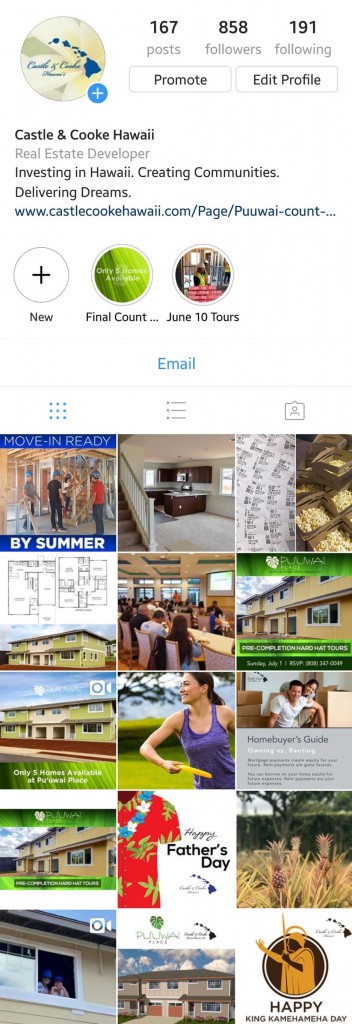
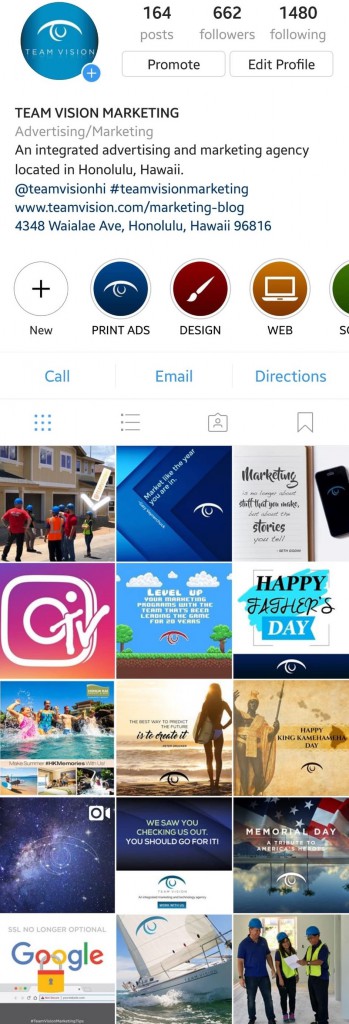
If you’re feeling overwhelmed trying to keep up with managing your business’s social media, give Team Vision Marketing a call and let us help you out. In the meantime, check out some of our social media programs and promotions on our web site portfolio at www.www.teamvision.com/portfolio/#social-media.
Phone: (808) 536-0416
Email: info@www.teamvision.com
Enjoy this article? Let us know below or share it!
Read More Team Vision Blog Posts on Social Media:
“Busting Social Media Marketing Myths #1”
Hear from Harry A. Saunders, President of Castle & Cooke Hawaii, on his experience working with Team Vision.
- How to Select The Best Hawaii Advertising Agency for Your Business
- How AI Will Transform Marketing
- What Is IP Targeting and How Can I Use It for My Business?
- Everything You Need to Know About Instagram’s “Hidden Likes” Test
- Hawaii Social Media Marketing Tips
- How To Succeed in Zero-Click Search SEO
- Social Media Marketing Trends
- Your Guide to Google Rich Search Features
- What to Expect After A Google Broad Core Algorithm Update
- Top 5 Facebook Story Sticker Tips
- Hawaii Search Engine Optimization – SEO Companies
- Top 10 Instagram Story Sticker Tips
- Know The Common Difference: Black Hat SEO vs. White Hat SEO
- 10 Types of Content That Will Boost Engagement
- Video Advertising is Growing – Are You Making the Shift?
- Why You Should Advertise on Facebook Messenger
- Buying Instagram Followers – Is It Worth The Money?
- Top 10 Instagram Hashtag Tips for 2019
- 2018 Social Media Trends: Were We Right On The Money?
- Dreaded Advertising Agency Requests Roundup
Call Us Today at (808) 536-0416.
Sources:
https://www.marketingweek.com/2017/08/30/roi-look-like-world-influencer-marketing/
https://www.adweek.com/digital/paul-johnson-lumanu-guest-post-wasting-money-on-influencer-marketing/
https://medium.com/@JBBC/17-common-social-media-marketing-myths-and-how-to-bust-them-ce70a70b8674
https://shanebarker.com/blog/influencer-marketing-tactics-amplify-boost-brand-presence/

June 19, 2018
Busting Social Media Marketing Myths #1
Accidentally landed on our Hawaii Marketing Tips blog while searching for Team Vision Marketing? Please visit our homepage, creative portfolio or client video testimonials. If you’re interested in learning more about the truth behind common social media myths, please continue reading below.
Busting Social Media Myths #1
Social media marketing has been around for years now, but some businesses still believe in old misconceptions surrounding it. Thus, they miss out on having a presence on social media or go about it the wrong way. As a leader in this field, we’d like to take this opportunity to dispel some common myths around social media marketing and help steer your business in the right direction.
Myth: Social Media only reaches Millennials and Gen Z

Source: Pew Research Center

Total myth! Although there are more Gen X, Millenials and Gen Z on social media, older generations are adapting to using technology and becoming more proactive on social media. In fact, their usage on social media is on the rise, as you can see in the graphs above provided by Pew Research Center.
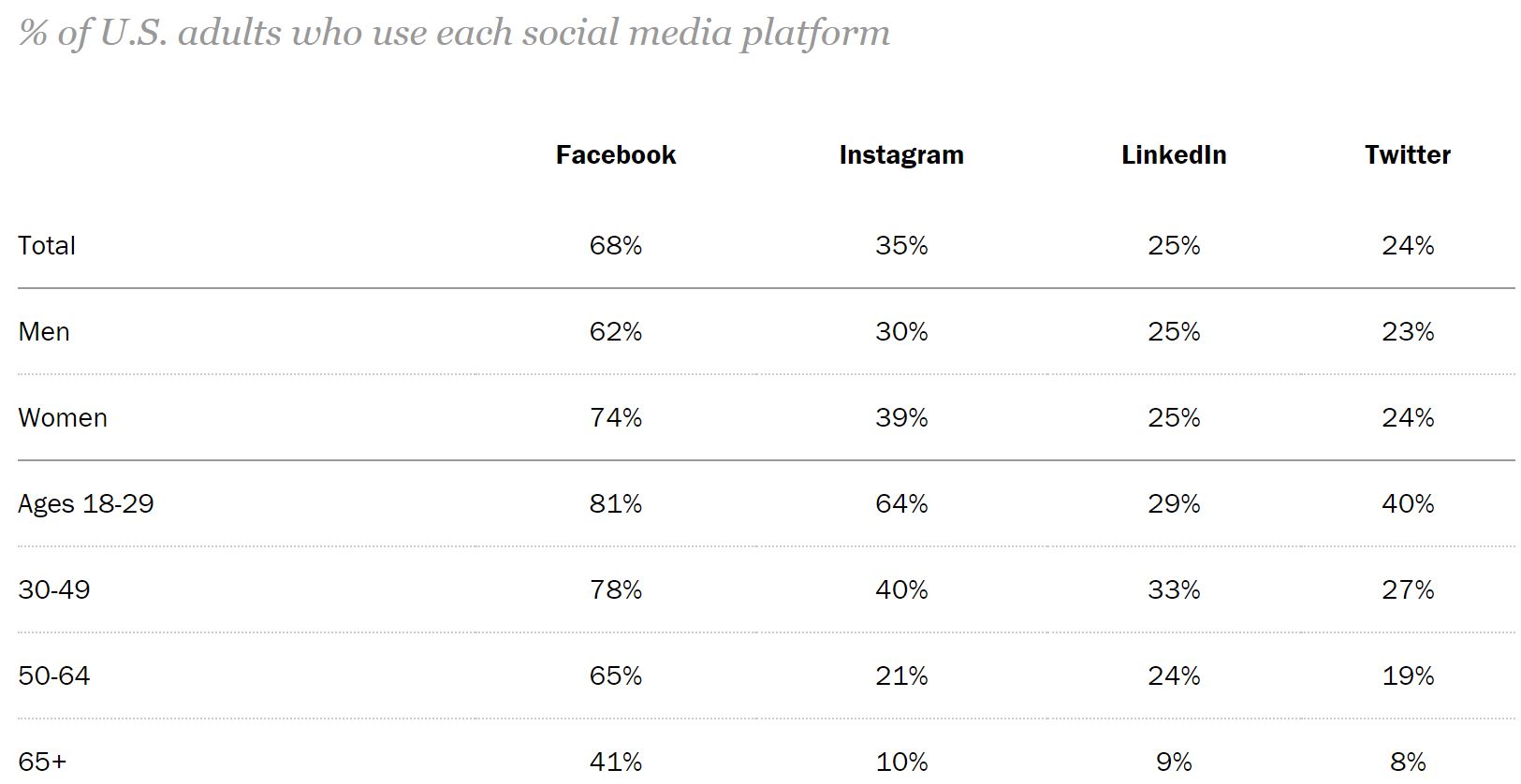
By looking at the table above, provided by Pew Research Center, you can see that there is a strong social media presence in the 50-64 and 65+ age groups, especially on Facebook.
Myth: I have to be on all Social Media networks
Not true at all. Although it may sound smart to cover all your bases, you should really only use the networks that work for your brand’s needs. This is because not every platform is equal attracts the same type of audience. For example, Facebook is more community based, while Twitter is more known for its breaking news content. It is very important to first define your social media marketing objectives and then pick the right social media channels and content strategy to help you achieve them.
Myth: Any young person who is good at social media can successfully run my business accounts
Age and popularity on personal social media accounts doesn’t necessarily translate into a person having the expertise to manage a brand on business accounts. Whoever manages your brand’s accounts has to not only “get” how to work the apps, but, among other things, be able to build and maintain a brand on them in engaging ways. Your best option is to work with a company that has a strong background in marketing, building brands, and that has managed social media accounts for some major brands in your market. They should also have access to a team of social media managers, copywriters, and graphic designers.
Myth: Social Media is Free Marketing for Businesses
This is only partially true. Setting up a profile and posting content is free, but this isn’t enough to have a successful social media presence. Most successful business on social media either have an experienced in-house social media manager, or hire a social media marketing agency to oversee their accounts, develop engaging content, field customer questions, and continuously engage in posting, liking and commenting on other social media profiles related to the business’s brand.
You will likely need to invest money and/or spend a lot of your own time building and maintaining quality social media channels. And let’s face it, time is money, so managing your own social media channels means you are pulling yourself away from your core business responsibilities. This is especially true now that the algorithms of social media feeds are favoring friends over businesses. This means that your business posts are less likely to appear on your Followers’ feeds and your organic reach is going to decrease as a result. After Facebook’s algorithm update in 2016, organic reach on posts dropped 52%. According to HootSuite, Instagram’s non-chronological algorithm update makes users miss 70% of the content in their feeds. Social media channels are pushing harder than ever on paid reach, which means you have to buy ads or boost posts in order for them to reach a substantial audience. If you have a current Facebook page, chances are you have seen your Reach and Likes per post drop substantially over the past couple years. It’s becoming a “pay to play” game.
We also recommend hiring a creative team to design graphics that capture the true essence of your brand or promotion, like the Instagram ads below, which we created for Honua Kai Resort & Spa’s Suite Summer Escape promotion. Having an aesthetic feed is vital for attracting new followers, likes, and link clicks.


You should also consider investing in analytic tools to gain insightful information about your customer profile and to track important data.
If you’re feeling overwhelmed trying to keep up with the management of your businesses social media accounts, give Team Vision Marketing a call and let us help you out. In the meantime, check out some of our social media programs and promotions on our web site portfolio at www.www.teamvision.com/portfolio/#social-media.
Web: www.www.teamvision.com
Phone: (808) 536-0416
Email: info@www.teamvision.com
Hear from Dolly Moreno, Director of Sales & Marketing at Honua Kai Resort & Spa Maui, on her experience working with Team Vision Marketing.
- How to Select The Best Hawaii Advertising Agency for Your Business
- How AI Will Transform Marketing
- What Is IP Targeting and How Can I Use It for My Business?
- Everything You Need to Know About Instagram’s “Hidden Likes” Test
- Hawaii Social Media Marketing Tips
- How To Succeed in Zero-Click Search SEO
- Social Media Marketing Trends
- Your Guide to Google Rich Search Features
- What to Expect After A Google Broad Core Algorithm Update
- Top 5 Facebook Story Sticker Tips
- Hawaii Search Engine Optimization – SEO Companies
- Top 10 Instagram Story Sticker Tips
- Know The Common Difference: Black Hat SEO vs. White Hat SEO
- 10 Types of Content That Will Boost Engagement
- Video Advertising is Growing – Are You Making the Shift?
- Why You Should Advertise on Facebook Messenger
- Buying Instagram Followers – Is It Worth The Money?
- Top 10 Instagram Hashtag Tips for 2019
- 2018 Social Media Trends: Were We Right On The Money?
- Dreaded Advertising Agency Requests Roundup









